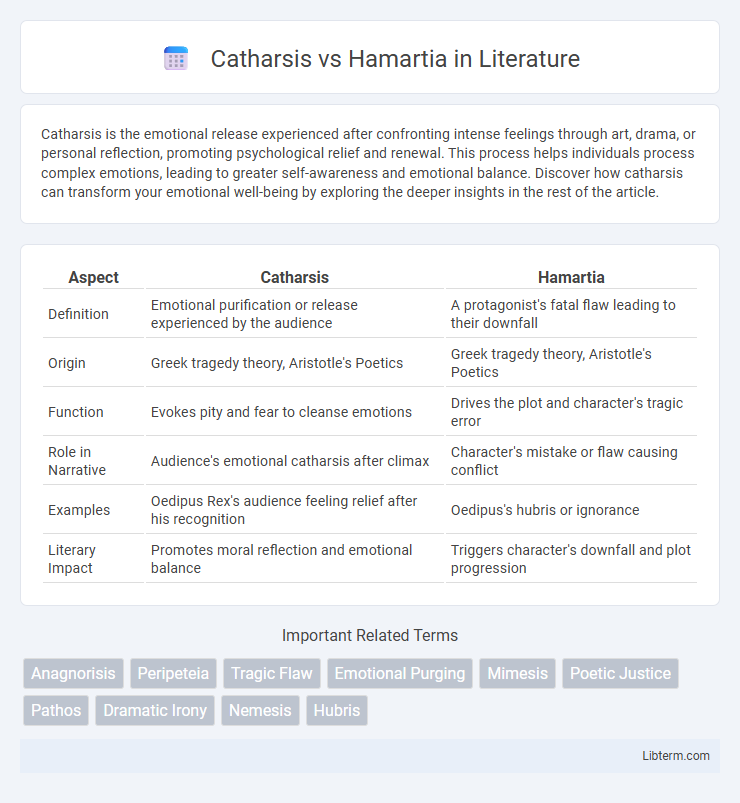Catharsis is the emotional release experienced after confronting intense feelings through art, drama, or personal reflection, promoting psychological relief and renewal. This process helps individuals process complex emotions, leading to greater self-awareness and emotional balance. Discover how catharsis can transform your emotional well-being by exploring the deeper insights in the rest of the article.
Table of Comparison
| Aspect | Catharsis | Hamartia |
|---|---|---|
| Definition | Emotional purification or release experienced by the audience | A protagonist's fatal flaw leading to their downfall |
| Origin | Greek tragedy theory, Aristotle's Poetics | Greek tragedy theory, Aristotle's Poetics |
| Function | Evokes pity and fear to cleanse emotions | Drives the plot and character's tragic error |
| Role in Narrative | Audience's emotional catharsis after climax | Character's mistake or flaw causing conflict |
| Examples | Oedipus Rex's audience feeling relief after his recognition | Oedipus's hubris or ignorance |
| Literary Impact | Promotes moral reflection and emotional balance | Triggers character's downfall and plot progression |
Understanding Catharsis: Definition and Origins
Catharsis, originating from Aristotle's Poetics, refers to the emotional purification or relief experienced by the audience through the unfolding of a tragedy. It involves the purging of pity and fear, allowing viewers to achieve a sense of renewal and emotional balance. This concept is integral to classical drama, emphasizing the psychological impact of storytelling and the transformative power of tragic narratives.
Exploring Hamartia: Meaning and Context
Hamartia refers to a protagonist's tragic flaw or error in judgment that precipitates their downfall in classical Greek tragedy, embodying a critical misstep rather than inherent evil. This concept, first articulated by Aristotle in "Poetics," emphasizes the role of human frailty and moral ambiguity within the narrative, drawing audiences into a deeper understanding of character complexity and fate. Unlike catharsis, which involves the emotional purging experienced by the audience, hamartia centers on the internal cause that initiates the tragic sequence, highlighting the nuanced interplay between personal choice and destiny.
Catharsis in Classical Tragedy
Catharsis in classical tragedy refers to the emotional purification or relief experienced by the audience through the protagonist's intense suffering and downfall. This concept, rooted in Aristotle's Poetics, emphasizes the cleansing of pity and fear, enabling spectators to achieve psychological renewal. Unlike hamartia, which denotes the protagonist's fatal flaw leading to their demise, catharsis focuses on the audience's transformative emotional response to the tragic narrative.
Hamartia as the Tragic Flaw
Hamartia, often defined as the tragic flaw, is a fundamental weakness or error in judgment that leads to the protagonist's downfall in classical tragedy. This concept drives the narrative tension by highlighting how a character's inherent imperfection causes inevitable suffering, differentiating it from catharsis, which is the emotional release experienced by the audience. Understanding hamartia is crucial for analyzing tragic heroes like Oedipus, whose fatal flaw precipitates a sequence of irreversible consequences.
Aristotle’s Perspectives on Catharsis and Hamartia
Aristotle's perspective on catharsis involves the emotional purification or purgation experienced by the audience through feelings of pity and fear during a tragedy, leading to psychological relief. Hamartia, as defined by Aristotle, refers to the protagonist's tragic flaw or error in judgment that ultimately causes their downfall, highlighting human imperfection. Together, catharsis and hamartia are central to Aristotle's Poetics, shaping the structure and emotional impact of classical tragedy by eliciting empathy and moral reflection.
Key Differences Between Catharsis and Hamartia
Catharsis refers to the emotional release or purification experienced by the audience during a tragedy, often resulting in feelings of relief and renewal, whereas hamartia is the protagonist's tragic flaw or error in judgment that leads to their downfall. Catharsis is an effect on the audience, emphasizing emotional cleansing, while hamartia is a character trait or mistake driving the plot. These concepts are central to Aristotelian tragedy, highlighting the interplay between character flaws and audience emotional experience.
The Role of Catharsis in Audience Experience
Catharsis plays a crucial role in the audience experience by providing emotional release and psychological cleansing through the unfolding of tragedy. Unlike hamartia, which refers to the protagonist's tragic flaw or error leading to their downfall, catharsis allows the audience to confront and purge feelings of pity and fear. This emotional journey enhances empathy and offers a deeper understanding of human vulnerability and moral complexity.
Examples of Hamartia in Famous Tragedies
Hamartia, often defined as a tragic flaw or error in judgment, is vividly illustrated in Shakespeare's *Macbeth* where ambition drives the protagonist to his downfall. In Sophocles' *Oedipus Rex*, Oedipus' hamartia is his hubris and determination to uncover the truth, which ultimately leads to his tragic fate. Similarly, in *Hamlet*, the prince's indecisiveness and obsession with revenge exemplify hamartia as the catalyst for the play's tragic events.
Interplay Between Catharsis and Hamartia
The interplay between catharsis and hamartia is essential in classical tragedy, where the protagonist's hamartia, or tragic flaw, triggers a series of events culminating in emotional catharsis for the audience. This process allows spectators to experience intense emotions such as pity and fear, ultimately leading to a purging or cleansing of these feelings. The dynamic tension generated by the hero's flawed actions and their consequences deepens the emotional impact, reinforcing the moral and psychological themes central to tragic narratives.
Relevance of Catharsis and Hamartia in Modern Literature
Catharsis in modern literature serves as an emotional purging that connects readers deeply with characters' transformative journeys, enhancing psychological realism and empathy. Hamartia remains relevant as a critical element in character development, underscoring the flaws that precipitate conflict and drive narrative tension within contemporary storytelling. Together, catharsis and hamartia enrich modern narratives by fostering complex character arcs and profound emotional engagement.
Catharsis Infographic

 libterm.com
libterm.com